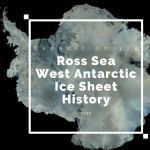
Ross Sea West Antarctic Ice Sheet History

Earth has experienced many cycles of climate change throughout its geologic history. Records of this past can be found in layers of sediment beneath the seafloor.
Expedition 374 will look back in time 20 million years ago to see how the West Antarctic Ice Sheet (WAIS) experienced this climate change, and what it could mean for a warmer world in the future.
The Ross Sea is an ideal location for this study because it is highly sensitive to changes in ocean heat flux and sea level. This work can lead to a better understanding of WAIS sensitivity to warmer climates.
Source: http://www.vanishing-ice.org/the-antarctic-a-continent-surrounded-by-ocean/
Expedition 374 will core six sites in the Ross Sea from January to March 2018 to understand how the WAIS evolved with climatic and oceanic change, particularly the sensitivity of WAIS mass balance during warmer-than-present climates through the Neogene and Quaternary Periods, more specifically in the Pliocene and middle Miocene. Four sites will be on the continental shelf and two on the continental slope, under 490 to 2400 meters of water.

Source: NASA
Scientists onboard will describe what the sediments are made of, identify fossils to tell when and where the sediments formed, and observe the interactions between ocean and ice sheet. This information will be put in context with other data from the region, particularly from ANDRILL and DSDP Leg 28 sites.

A typical sediment core from Antarctica. Source: ANDRILL
The Ross Sea is an ideal location for this study because it is a wide continental shelf that still preserves thick paleoclimate archives in the sediments deposited during past ice sheet advances and retreats in glacial and interglacial times. The continental shelf here is only partially covered by the Ross Ice shelf and today we can easily access and observe the footprints on the sea bed of the past grounding ice streaming and bottom water current pathways. The Ross Sea is therefore a key place to investigate how the largest ice sheet of the planet is responding today and in the past to changes in ocean heat flux and sea level. For the past several decades, the Southern Ocean has warmed and the Southern Hemisphere westerly winds have strengthened. Scientists link these observations to the thinning of the ice shelves around Antarctica today.
We know that ice shelves are critical in climate regulation because they protect and stabilize ice sheets, playing a fundamental role in controlling ocean heat. Learning more on how Ross ice shelf has evolved during the past will help us to increase our understanding of Antarctica’s past, and its future role in global climate.
 Source: https://serc.carleton.edu/eet/cores/teaching_notes.html
Source: https://serc.carleton.edu/eet/cores/teaching_notes.html
Want to follow this expedition?
Sign up for a broadcast to connect with the JR scientists onboard here.







































